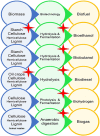Halophiles and Their Vast Potential in Biofuel Production
- PMID: 31507545
- PMCID: PMC6714587
- DOI: 10.3389/fmicb.2019.01895
Halophiles and Their Vast Potential in Biofuel Production
Abstract
Global warming and the limitations of using fossil fuels are a main concern of all societies, and thus, the development of alternative fuel sources is crucial to improving the current global energy situation. Biofuels are known as the best alternatives of unrenewable fuels and justify increasing extensive research to develop new and less expensive methods for their production. The most frequent biofuels are bioethanol, biobutanol, biodiesel, and biogas. The production of these biofuels is the result of microbial activity on organic substrates like sugars, starch, oil crops, non-food biomasses, and agricultural and animal wastes. Several industrial production processes are carried out in the presence of high concentrations of NaCl and therefore, researchers have focused on halophiles for biofuel production. In this review, we focus on the role of halophilic microorganisms and their current utilization in the production of all types of biofuels. Also, the outstanding potential of them and their hydrolytic enzymes in the hydrolysis of different kind of biomasses and the production of biofuels are discussed.
Keywords: biodiesel; bioethanol; biofuel; biogas; halophile.
Figures
References
-
- Abdullah M. A., Usman S. M., Shah A. A., El-Sayed H. (2015). “Algal biotechnology for bioenergy, environmental remediation and high-value biochemical,” in Biotechnology and Bioinformatics, eds Thangadurai D., Sangeetha J. (Oakville, ON: CRC Press; ), 301–344.
-
- Abomohra A. E. F., El-Sheekh M., Hanelt D. (2017). Screening of marine microalgae isolated from the hypersaline Bardawil lagoon for biodiesel feedstock. Renew. Energy 101 1266–1272. 10.1016/j.renene.2016.10.015 - DOI
-
- Aikawa S., Joseph A., Yamada R., Izumi Y., Yamagishi T., Matsuda F., et al. (2013). Direct conversion of Spirulina to ethanol without pretreatment or enzymatic hydrolysis processes. Energy Environ. Sci. 6 1844–1849.
-
- Ali I., Akbar A., Anwar M., Prasongsuk S., Lotrakul P., Punnapayak H. (2015). Purification and characterization of a polyextremophilic α-amylase from an obligate halophilic Aspergillus penicillioides isolate and its potential for souse with detergents. Biomed. Res. Int. 1 1–8. 10.1155/2015/245649 - DOI - PMC - PubMed
Publication types
LinkOut - more resources
Full Text Sources


